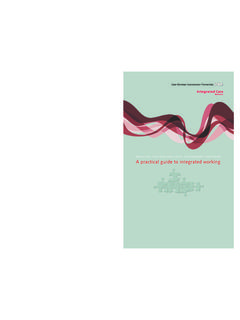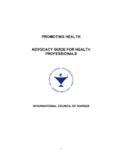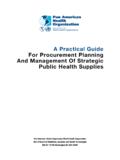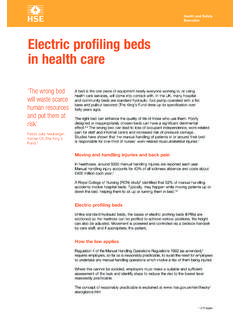Transcription of CERTIFICATE/DIPLOMA IN HEALTH AND SOCIAL CARE
1 ANATOMY AND PHYSIOLOGY FOR HEALTH AND SOCIAL CARER/600/8956 LEVEL 3 UNIT 5 GUIDED LEARNING HOURS: 60 UNIT CREDIT VALUE: 10 OCR LEVEL 3 CAMBRIDGE TECHNICALCERTIFICATE/DIPLOMA INHEALTH AND SOCIAL AND PHYSIOLOGY FOR HEALTH AND SOCIAL CARER/600/8956 LEVEL 3 UNIT 5 AIM OF THE UNITWe eat, we breathe, but why? This unit aims to enable learners to understand why these essential processes are so important in maintaining life. In investigating the answers learners will discover the structure and function of not only the cells and tissues involved, but how they form organs and body systems that have to interact to ensure that the body can provide the conditions necessary for thought, movement, growth and development.
2 These systems could so easily spin out of control with disastrous results to our HEALTH , and so learners will be able to explore the homeostatic mechanisms that ensure stability of conditions within the OF THE UNIT Working in the HEALTH and SOCIAL care sector will often involve either giving HEALTH advice to individuals or caring for them. Relatives and friends of people with HEALTH issues will be hungry for information. This unit will give learners the opportunity to develop a broad understanding of the body, its workings and its organisation and will provide a foundation of applicable will start with a basic knowledge of cellular structure and function, especially concentrating on the role energy has in driving the processes of the body and how this energy is obtained.
3 Learners will examine how certain systems work together in providing the necessary requirements for energy production and removing potentially poisonous by-products from the body. Whilst certain systems and tissues will be explored in depth from both an anatomical and functional point of view, learners will also be taken on a brief overview of all major organs and systems of the body, not only discovering their location but what they within the body are constantly changing and this could have lethal effects. Many human dysfunctions that learners may encounter whilst working in the HEALTH and SOCIAL care sector are the result of disturbances of these conditions.
4 Learners will have the opportunity to study how these harmful effects are avoided in the healthy body by homeostatic mechanisms. They will be able to observe some of these regulatory processes in action by undertaking simple practical activities that will require them to take measurements of the cardiovascular and respiratory systems along with body temperature using non-invasive unit will provide a core understanding and knowledge of human anatomy and physiology that will allow progression on to further specialised physiology units. The unit further encourages learners to develop a working comprehension of the body s operations that may well influence the lifestyle decisions they themselves make or the advice and help they give to and Physiology for HEALTH and SOCIAL care Level 3 Unit 51 Know the organisation of the human body2 Understand the functioning of the body systems associated with energy metabolism3 Understand how homeostatic mechanisms operate in the maintenance of an internal environment4 Be able to interpret data obtained from monitoring routine activities with reference to the functioning of healthy body systemsP1 outline the functions of the main cell
5 ComponentsP2 outline the structure of the main tissues of the bodyP3 outline the gross structure of all the main body systemsP4 explain the physiology of two named body systems in relation to energy metabolism in the bodyP5 explain the concept of homeostasisP6 follow guidelines to collect data for heart rate, breathing rate and temperature before and after a standard period of exerciseM1 explain how two body systems interrelate to provide for the body s energy needsM2 explain how the body maintains the optimum conditions for energy metabolismM3 explain measures taken to ensure validity and reliability during the practical investigationD1 analyse how systems of the body use energyD2 analyse the consequences of homeostatic processes failing in the bodyASSESSMENT AND GRADING CRITERIAL earning Outcome (LO)
6 Pass Merit Distinction The assessment criteria are To achieve a merit the To achieve a distinction the pass requirements for evidence must show that, the evidence must show this unit. in addition to the pass that, in addition to the pass criteria, the learner is able to: and merit criteria, the The learner will: The learner can: learner is able to: CONTENT1 Know the organisation of the human body Organisation: cells; tissues; organs; systems Cells: cell membrane, nucleus, chromosomes; cytoplasm; mitochondria; endoplasmic reticulum; ribosomes; Golgi apparatus, lysosome Tissues: The basic structure and function of: Epithelial: squamous, ciliated, goblet cells Blood: red blood cells, white blood cells, platelets Cartilage and bone Areolar tissue Adipose tissue Striated muscle Sensory and motor neurons.
7 Location of body organs: heart, lungs, brain and spinal cord, stomach, liver, pancreas, duodenum, ileum, colon, rectum, kidneys, bladder, ovaries/testes, oviducts, uterus. The gross structure of body systems: cardiovascular - heart, arteries, veins, capillaries; respiratory; digestive; renal; nervous central nervous system and peripheral nerves; endocrine thyroid, pituitary, pancreas, adrenals, testes/ovaries; reproductive (both genders); musculoskeletal a named joint, antagonistic muscles around a named joint, section through a bone functions of systems: Overall function of each system shown above plus those of the lymphatic and immune Understand the functioning of the body systems associated with energy metabolism Energy metabolism: Role of energy in the body; anabolism and catabolism; the significance of ATP; cellular respiration and its by-products; endothermy of mammals; muscle action; protein synthesis.
8 The roles of the cardiovascular, respiratory and digestive systems in supplying the necessary molecules and in removing by-products: Cardiovascular system cardiac cycle, heart rate, role of pacemaker, blood pressure, pulmonary and systemic circulation, formation of tissue fluid Respiratory system inspiration, expiration, gaseous exchange Digestive system role in digestion and absorption of nutrients (carbohydrates, proteins, fats and nucleic acids); role of enzymes (amylases, proteases, lipases and nucleases); products of digestion (amino acids, sugars, glycerol and fatty acids, nucleotides), their absorption and subsequent roles in metabolism; the storage of excess fats and carbohydrates; deamination of excess proteins and the fate of end products; roles of the liver and and Physiology for HEALTH and SOCIAL care Level 3 Unit 53 Understand how homeostatic mechanisms operate in the maintenance of an internal environment Homeostasis: definition; the need for a constant internal environment and the consequences of any major disturbances.
9 The concept of negative feedback Homeostatic mechanisms for the regulation of: Heart rate Blood pressure Breathing rate Body temperature Blood glucose levels Blood concentration Be able to interpret data obtained from monitoring routine activities with reference to the functioning of healthy body systems Measurements: pulse rate, breathing rate, temperature, blood pressure; normal values and ranges; safe practice and recognition of factors affecting reliability of measurements Normal variation: resting values, values after exercise, recovery times Data presentation: graphs, charts and interpretations/explanations of collated GUIDANCELO1 Learners need to develop an understanding of the human body and how it operates at various levels from cellular to whole body systems.
10 They need to appreciate the basic structure of a generalised cell and the essential functions of the organelles found inside. This work does not require access to science laboratories. Prepared or self-made microscope slides can be used to investigate cell and tissue structure if this is possible. Alternatively, images from slide packs, DVDs, books, websites could be used to illustrate these. Provided images could be identified and annotated by the learners. Models of cells can be made easily using a variety of media either individually or on a larger scale as a group activity. There could be teacher led research on cell structure and function of cell organelles with group discussion/ Blockbuster quiz/ class mind maps to reinforce knowledge and understanding.
















